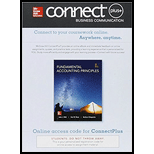
Concept Introduction:
Cash Flow from Operating Activities:
Cash flow from operating activities includes the inflow from principal revenue generating activities of enterprise. In other words inflow from activities that are not financing and investing activities.
Total Assets:
Total Assets includes the Non-Current Assets and Current Assets of an enterprises.
Average Total Assets:
Average total assets can be calculated by using the formula mentioned below
Current Assets:
Current Assets are the assets that are either in the form of Cash & Cash Equivalents or can be converted into Cash or Cash Equivalent within a short period of time i.e. 12 months.
Non-Current Assets:
Non-Current Assets are those assets which are not current assets. It includes Fixed Assets (Tangible and intangible), Long term Investments, Long term loans and advances and other non-current assets.
Cash Flow on Total Assets Ratio:
It is an efficiency ratio used to calculate the efficiency of Assets to generate
To Calculate:
The Cash Flow to Total Assets Ratio of Company for Fiscal Year 2015 and 2014
Want to see the full answer?
Check out a sample textbook solution
Chapter 16 Solutions
Connect 2-Semester Access Card for Fundamental Accounting Principles
- Kindly help me with this General accounting questions not use chart gpt please fast given solutionarrow_forwardPlease provide the accurate answer to this general accounting problem using appropriate methods.arrow_forwardI am looking for the correct answer to this financial accounting problem using valid accounting standards.arrow_forward
- Cooper Industries disposed of an asset at the end of the sixth year of its estimated life for $12,500 cash. The asset's life was originally estimated to be 8 years. The original cost was $76,000 with an estimated residual value of $6,000. The asset was being depreciated using the straight-line method. What was the gain or loss on the disposal? Helparrow_forwardCooper Industries disposed of an asset at the end of the sixth year of its estimated life for $12,500 cash. The asset's life was originally estimated to be 8 years. The original cost was $76,000 with an estimated residual value of $6,000. The asset was being depreciated using the straight-line method. What was the gain or loss on the disposal?arrow_forwardI need guidance with this general accounting problem using the right accounting principles.arrow_forward

 AccountingAccountingISBN:9781337272094Author:WARREN, Carl S., Reeve, James M., Duchac, Jonathan E.Publisher:Cengage Learning,
AccountingAccountingISBN:9781337272094Author:WARREN, Carl S., Reeve, James M., Duchac, Jonathan E.Publisher:Cengage Learning, Accounting Information SystemsAccountingISBN:9781337619202Author:Hall, James A.Publisher:Cengage Learning,
Accounting Information SystemsAccountingISBN:9781337619202Author:Hall, James A.Publisher:Cengage Learning, Horngren's Cost Accounting: A Managerial Emphasis...AccountingISBN:9780134475585Author:Srikant M. Datar, Madhav V. RajanPublisher:PEARSON
Horngren's Cost Accounting: A Managerial Emphasis...AccountingISBN:9780134475585Author:Srikant M. Datar, Madhav V. RajanPublisher:PEARSON Intermediate AccountingAccountingISBN:9781259722660Author:J. David Spiceland, Mark W. Nelson, Wayne M ThomasPublisher:McGraw-Hill Education
Intermediate AccountingAccountingISBN:9781259722660Author:J. David Spiceland, Mark W. Nelson, Wayne M ThomasPublisher:McGraw-Hill Education Financial and Managerial AccountingAccountingISBN:9781259726705Author:John J Wild, Ken W. Shaw, Barbara Chiappetta Fundamental Accounting PrinciplesPublisher:McGraw-Hill Education
Financial and Managerial AccountingAccountingISBN:9781259726705Author:John J Wild, Ken W. Shaw, Barbara Chiappetta Fundamental Accounting PrinciplesPublisher:McGraw-Hill Education





